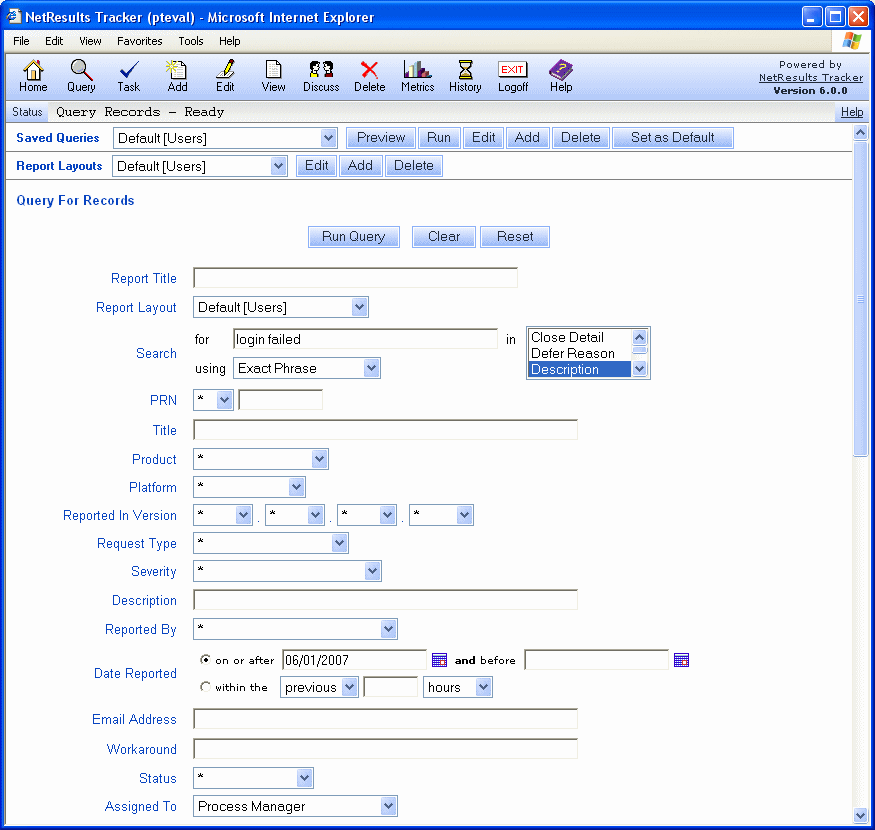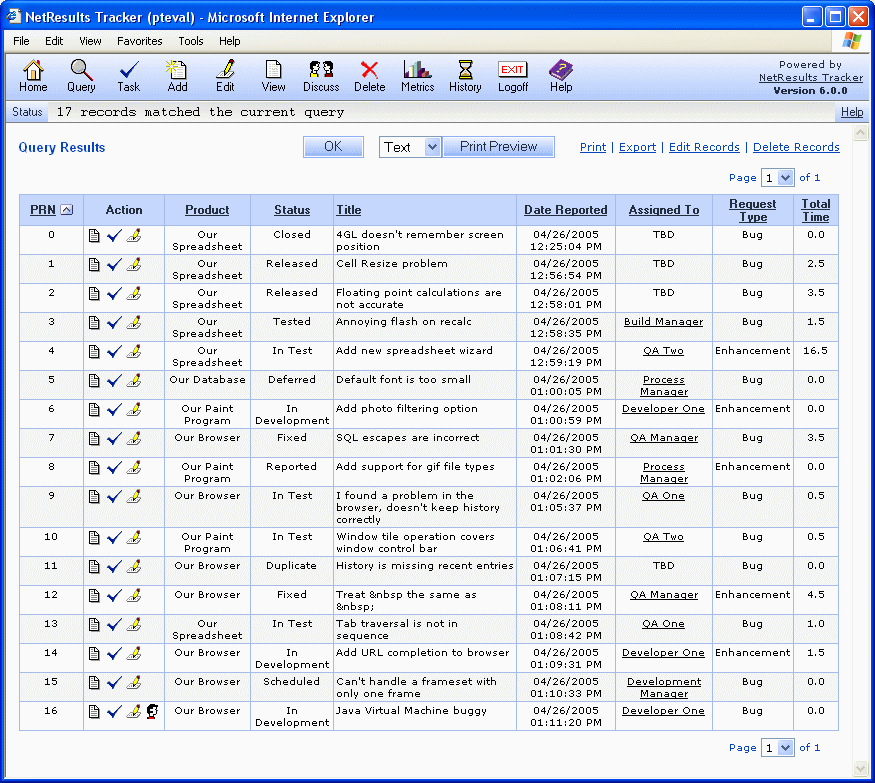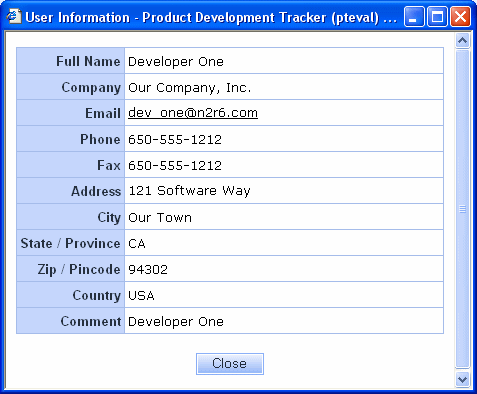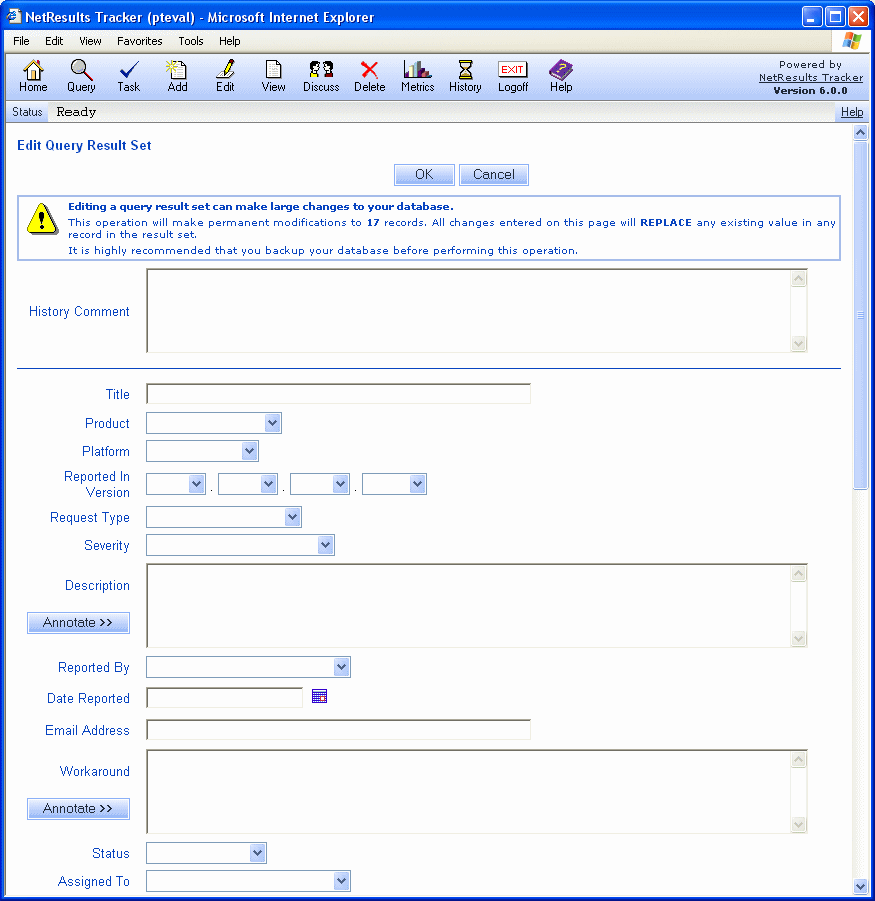|
||
|
|
 The Query page is the section where reports can be generated.
You can generate ad-hoc reports, create and run saved reports,
create report layouts to choose which fields will be displayed in
report results as well as print, export and edit the report results.
The Query page is the section where reports can be generated.
You can generate ad-hoc reports, create and run saved reports,
create report layouts to choose which fields will be displayed in
report results as well as print, export and edit the report results.
The Query page has several sections, each section operates independently of the others (except for the Preview button in the Saved Queries bar which can be used on both saved and advanced saved queries):

To run an ad-hoc query:
The Clear button in the Query for Records section can also be used to set the criteria such that the query will return all records. To run a query that returns all records:
A Reset button is available in the Query for Records section, allowing you to restore each query field to the values which were used in the last query that was run. This function is useful if you wish to use a previously executed query as a baseline for further queries.
Query criteria is entered or selected differently for the various field types available in Tracker.
Project
This field is only available if you have been given visibility to more
than 1 project in Tracker.
You can limit the query criteria to only those records that belong to
a particular project(s) or select * to match any project.
The selection made in this field will determine the options available in
the Form field. To select multiple projects, hold down the
Ctrl button on your keyboard while clicking on the projects
to select them.
Form
This field is only available if you have been given visibility to more
than 1 form in Tracker.
You can limit the query criteria to only those records that were
submitted using a particular form(s) or select *
to match any form. The selection made in this field determines which
fields are available for selecting query criteria. To select multiple forms,
hold down the Ctrl button on your keyboard while clicking on the
desired forms to select them. If you have selected
one or more forms, a Get Fields button will be displayed.
Click on the Get Fields button to refresh the page with the fields
that belong to the forms you have selected.
Assigned To
You can select any active user or user group within the system
or select * to match any user.
User groups are denoted as [user group] within the pulldown.
Clone
You can select "Yes" to match only records that are clones of
other records, or select "No" to match only records that are not
clones of other records, or select * to match any records
irrespective of whether it is a clone.
Date
Select a start date in the On or After field and, if desired,
an end date in the AND Before field for the date period you wish to
match. To match any value, leave the field blank. You can either type in
the date(s) or click on the calendar icon to select a date. In the calendar,
click on the < or > to move backward or forward
one month. Click on the << or >> to
move backward or forward one year. Click Now to set the date field to be the current date and time.
Click on Exclude Time if you want to exclude the time
information from being saved in the date field. For a field where the time information
has previously been excluded, click Set Time if you wish to include the current
time information in the field. Click OK to choose the
highlighted date to be entered into the date field. Date will be selected and calendar dismissed when
a date is clicked when the time is excluded. Dates displayed in
red are non-business days according to the
Business Days option in the Preferences
section. Click Cancel to dismiss the calendar without saving changes.
Another option is to search within a relative date range (e.g. all records reported within the last 2 weeks or all records with a Due Date in the next 3 days). Select the radio button to the left of the option called within the, select "previous" or "next", enter an integer to specify how many increments of time to include in the range and select the time increment desired (days, weeks, months or years). The results will be returned using the current date and time as the reference point. For example, if you run a query on June 15, 2006 12:20:00 PM that will return all records reported in the previous 2 days, the results will include all records that have a Date Reported between June 13, 2006 12:20:00 PM and June 15, 2006 12:20:00 PM.
Deleted
You can select "No" to include only records that are not marked as
deleted, or select "Yes" to match only records that are marked as
deleted, or select * to match any records irrespective of whether it
is marked deleted.
Discussion Subscription
You can select "Yes" to return records that contain a discussion thread
to which you are subscribed, or select "No" to return records that do not
contain a discussion thread to which you are subscribed, or select
* to return any records irrespective of whether it contains a discussion
thread to which you are subscribed.
Float (Floating Point Number)
You can specify a value and one of the following conditions: <,
<=, >, >= and =.
To match any value, select the condition * and leave the value blank.
Integer
You can specify a value and one of the following conditions: <,
<=, >, >= and =.
To match any value, select the condition * and leave the value blank.
PRN
You can specify a value and one of the following conditions: <,
<=, >, >= and =.
To match any value, select the condition * and leave the value blank.
Pulldown
You can pick any particular value, or select * to match any value.
Release Number
You can pick any particular value, or select * to match any value
in each of the 4 values for Release Number type fields.
Reported By
You can select any user or user group within the system or
select * to match any user.
User groups are denoted as [user group] within the pulldown.
Status
You can select any currently defined workflow state, or a State Group or
select * to match any value.
State Groups allow you to define collections of states to query
against. For example, your Administrator
could define a State Group named "Active" that includes all the
states except for "Closed". Check with your Tracker
Administrator for information about state groups that have been created in
your workgroup.
Text or TextArea
You can enter a key word or phrase you wish to match in a Text or
TextArea type field or leave blank to match any value. If you wish
to search for a key word or phrase in multiple Text or TextArea fields,
use the Full Text Search option.
URL
You can enter a key word or string you wish to match in a URL
type field or leave blank to match any value.
YesNo
You can pick "Yes" or "No" or select * to match any value.
Full Text Search
A Full Text Search option is available in the sub-section called Search (below the Report Layout field) when running ad-hoc queries. To include a full text search as part of your query criteria, enter a key word(s) or phrase into the for. All Text and TextArea type fields that are active in the database will be displayed in the in field. Select the Text and TextArea fields that you want to include in the search for your key word(s) or phrase. Select the search method you wish to use in the using field. Search Methods
Search Method Examples
|
Dependent Pulldowns
In some cases, your Tracker Administrator may have configured dependent pulldowns in the system. A set of dependent pulldowns is a pair of pulldown menus where one pulldown is the child pulldown field and the other is the parent pulldown field. The option menu items that are displayed in the child pulldown field are determined by the option menu item that is selected for the parent pulldown field. A simple example to illustrate this functionality:
A system has a pulldown called Product with two option menu items "Our Computer" and "Our Printer". A pulldown called Component has the option menu items "Hard Drive", "Video Card", "Toner", and "Paper Tray". The components "Hard Drive" and "Video Card" correspond to the "Our Computer" option menu item in the Product pulldown field. The components "Toner" and "Paper Tray" correspond to the "Our Printer" option menu item in the Product field. When a user selects "Our Computer" for the Product field, only the options "Hard Drive" and "Video Card" will be displayed in the Component field. The Component pulldown (child) is dependent on the Product pulldown (parent).
By default, these relationships between pulldown fields are not enforced when running queries. If you would like these dependencies between pulldown fields to be enforced when you perform queries (including the queries that display your home page reports), change the setting Enforce Dependency in Query Page to be set to Yes in the Preferences section. To do this,
Obsolete Items
In some cases, your Tracker Administrator may mark some option menu items as obsolete. An obsolete option menu item is a value in a pulldown field that cannot be selected for new records, but may be contained in existing records. When running queries, you may wish to search using obsolete items. If you would like for obsolete option menu items to be available to be used as part of search criteria on the Query Page:
Examples of Queries
|
Query Results
Once you have run a query, you can view, task, edit or view discussion threads to which you are subscribed for any of the records listed in the query results. You can change the sort order of the Query results at any time by clicking on the field name of the column you wish to sort by. The initial sort order is based on the selections made in the Sort By options of the Query for Records section or in the saved query. The field that is being used as the primary sort field will have an arrow to the right of the field name. If the arrow is pointing down, the results are sorted by that field in a descending order. If the arrow is pointing up, the results are sorted by that field in an ascending order. Clicking once on the field with the arrow will reverse the sort order. Clicking once on any field that does not have the arrow will sort the results in ascending order by that field. Any field except Link and TextArea type fields can be clicked to sort the results by that field. Please note that when the preference Exclude Time From Reports is enabled and a Date field is selected in the Sort By section, the report results will be sorted by the time in each record even though the report will not display the time information. When PRN (Record ID) is selected for one of the Sort By fields, the records will be ordered according to the numeric component of the PRN (Record ID) field. The short name of the form will not be used as part of the sorting when PRN (Record ID) is selected. For example, let's say you have PRNs "REC1" and "REC2". The sorting will be done using "1" and "2", ignoring the "REC".

The number of query results displayed per page is based on the value of the field Maximum Records in the Report Settings section of your Preferences page. By default, this is set to display 20 records per page.

 Use the next page and previous page icons to navigate through the query results
or use the page pulldown to go directly to a specific page number.
Use the next page and previous page icons to navigate through the query results
or use the page pulldown to go directly to a specific page number.
When the "Assigned To" or "Reported By" fields are displayed in the query results and if you have the privilege that allows you to see user profile information, you can click on the user's name to display their profile details as shown below.

 If you have the appropriate privilege, you can click on this icon to view a record in the query results.
If you have the appropriate privilege, you can click on this icon to view a record in the query results.
 If you have the appropriate privilege, you can click on this icon to task a record in the query results.
If you have the appropriate privilege, you can click on this icon to task a record in the query results.
 If you have the appropriate privilege, you can click on this icon to edit the fields, attachments or source code
list in a record in the query results.
If you have the appropriate privilege, you can click on this icon to edit the fields, attachments or source code
list in a record in the query results.
 If you have the appropriate privilege, you can click on this icon to view the discussion threads to which you are subscribed
within a record in the query results.
If you have the appropriate privilege, you can click on this icon to view the discussion threads to which you are subscribed
within a record in the query results.
 If you have the appropriate privilege, you can click on this icon to view the discussion threads to which you
are subscribed with new messages posted within a record in the query results.
If you have the appropriate privilege, you can click on this icon to view the discussion threads to which you
are subscribed with new messages posted within a record in the query results.
The query results can be formatted for printing as a table or text (text will display the full contents of all fields, table format may truncate long fields based on the settings in the Report Layout you used). To print the query results, select "Text" or "Table" and click on the Print link in the upper right corner of the Query Page. If you wish to see a preview before printing, select "Text" or "Table", then click on the Print Preview button. Please note that when the preference Exclude Time From Reports is enabled and a Date field is displayed in the report layout, the time information will not be included (only the date) when print previewing or printing the query results.
The query results can be exported to a *.CSV file (comma separated values format) by clicking on the ,b>Export link in the upper right corner of the Query Results page. Please note that when the preference Exclude Time From Reports is enabled and a Date field is displayed in the report layout, the time information will not be included (only the date) when exporting the query results.
Editing or Deleting a Set of Query Results
If you have the appropriate privilege, you may also have the option to edit the set of query results displayed using the Edit Records link in the upper right corner of the Query Results page. The Edit Records option allows you to make changes to all of the records that matched your query in a single edit operation. Please note that using the Edit Records options can make large changes to your database and cannot be undone. By default, this option is only available to the Admin user. To use this operation after running a query, on the page where the query results are displayed, click on the Edit Records link in the upper right corner of the page. The Edit Records link will only be available when one Project and one Form are selected in the query criteria (if you only have access to one Project and one Form, these fields won't be displayed in the criteria and the Edit Records link will be available if you have the appropriate user group privilege). The Edit Records page (also known as the Edit Query Result Set page) will display the fields active in the database. Make changes to the fields you desire, then click OK. Click OK once again to confirm that this will change multiple records and cannot be undone. The image below shows the Edit Records page.

The Edit Records operation can also be used to set the Alerts settings for multiple records that matched your query in a single edit operation. If you wish to delete the alerts settings for all records in the query results, select Delete in the Alerts field at the bottom of the page. If you wish to modify the alerts settings for all records in the query results, select Modify... in the Alerts field at the bottom of the page. Please note that the Modify... option will only be available if the query results are limited to those records that belong to a single form. When the results include records from multiple forms, the Modify... option will not be available. When selecting Modify..., another page will be displayed where the alerts settings can be changed. To change a particular setting, click on the check box next to the setting as shown in the example below. Modify the alerts settings you wish to change, then click OK to save the changes for all records in the query results.
You can change the record visibility for a set of records using the Edit Records operation. A list of user groups will be displayed in the field Make Visible to These User Groups. If a user group(s) is selected during the Edit Records operation, the records in the query results will be set such that they are visible only to the user group(s) selected. To make a set of records visible to only the Admins user group, click on the blank space at the bottom of the list in the Make Visible to These User Groups field. Changing the visibility for a set of records will eliminate the visibility settings previously in effect for these records.
If you have the appropriate privileges and your system has been configured to use "hard" deletes (deletes which permanently purge records from the database), then you may see a Delete Records link in the upper right corner of the query results page. Clicking this link will (after asking for a final confirmation), permanently delete all records that matched the query you just ran. However, entries will be made to Record History for all records deleted in this manner. By default, Tracker is configured to perform only "soft" (recoverable) deletes and only the Administrator is able to perform the Delete Records operation (it requires the same privilege as Edit Records).